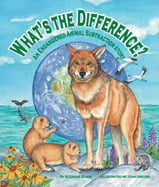Alignment to Standards for TN

| Grade | Number | Standard |
|---|---|---|
| 1 | SC-1.1.2.a | Observe and describe what happens when an object loses a part. |
| 1 | SC-1.2.3. | Examine interrelationships among plants, animals, and their environment. |
| 1 | SS-1.2.03.b | Differentiate between consumers and producers. |
| 2 | SC-2.2.4. | Recognize that the environment and the organisms that live in it can be affected by pollution. |
| 2 | SC-2.6.1.a | Recognize that some plants and animals that formerly inhabited the earth are no longer present on earth. |
| 3 | SC-3.2.3. | plants and animals depend upon each other and the non-living elements of an environment to meet basic needs. |
| 3 | SC-3.2.3. | Examine interrelationships among plants, animals, and their environment. |
| 3 | SC-3.3.1.a | Explain how animals depend on plants to meet their need for energy. |
| 4 | SC-4.2.2.a | Provide evidence and give examples of environmental changes caused by living things. |
| 4 | SC-4.3.1. | Realize that plants and animals use food for energy. |
| 4 | SC-4.3.1.a | Explain that animals must obtain and use food for energy. |
| 4 | SC-4.5.1. | Realize that plants and animals can be grouped according to similarities and differences in their characteristics. |
| 4 | SC-4.5.1.a | Classify animals, by type, according to their characteristics. |
| 4 | SC-4.6.2. | Recognize that extinction has occurred in the past and continues today. |
| 4 | SC-4.6.2.a | animal and plant populations as thriving, threatened, endangered, or extinct |
| 5 | SC-5.2.1.a | Classify specific kinds of relationships among plants and animals within an ecosystem. |
| 5 | SC-5.2.2.a | Predict the consequences of a human action on the environment. |
| 5 | SC-5.3.1. | Realize that plants and animals use food for energy. |
| 5 | SC-5.3.2. | Recognize the function of specific structures in organisms that allow them to obtain and use energy. |
| 5 | SC-5.5.1. | Realize that plants and animals can be grouped according to similarities and differences in their characteristics. |
| K | SC-K.5.2.a | Know that different organisms tend to be found in different environments. |